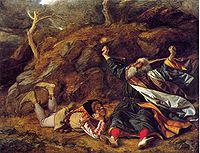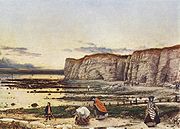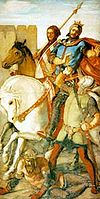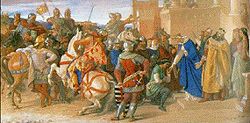
William Dyce
Encyclopedia

Scottish people
The Scottish people , or Scots, are a nation and ethnic group native to Scotland. Historically they emerged from an amalgamation of the Picts and Gaels, incorporating neighbouring Britons to the south as well as invading Germanic peoples such as the Anglo-Saxons and the Norse.In modern use,...
artist, who played a significant part in the formation of public art education
Art education
Art education is the area of learning that is based upon the visual, tangible arts—drawing, painting, sculpture, and design in jewelry, pottery, weaving, fabrics, etc. and design applied to more practical fields such as commercial graphics and home furnishings...
in the UK, as perhaps the true parent of the South Kensington Schools system.
Dyce began his career at the Royal Academy
Royal Academy
The Royal Academy of Arts is an art institution based in Burlington House on Piccadilly, London. The Royal Academy of Arts has a unique position in being an independent, privately funded institution led by eminent artists and architects whose purpose is to promote the creation, enjoyment and...
schools, and then traveled to Rome
Rome
Rome is the capital of Italy and the country's largest and most populated city and comune, with over 2.7 million residents in . The city is located in the central-western portion of the Italian Peninsula, on the Tiber River within the Lazio region of Italy.Rome's history spans two and a half...
for the first time in 1825. While he was there, he studied the works of Titian
Titian
Tiziano Vecelli or Tiziano Vecellio Tiziano Vecelli or Tiziano Vecellio Tiziano Vecelli or Tiziano Vecellio (c. 1488/1490 – 27 August 1576 better known as Titian was an Italian painter, the most important member of the 16th-century Venetian school. He was born in Pieve di Cadore, near...
and Poussin
Poussin
Poussin refers to:*Charles Jean de la Vallée-Poussin Belgian mathematician*Charles-Louis-Joseph-Xavier de la Vallée-Poussin Belgian geologist and mineralogist, father of Charles Jean*Nicolas Poussin , French painter...
. He returned to Rome
Rome
Rome is the capital of Italy and the country's largest and most populated city and comune, with over 2.7 million residents in . The city is located in the central-western portion of the Italian Peninsula, on the Tiber River within the Lazio region of Italy.Rome's history spans two and a half...
in 1827, this time staying for a year and a half, and during this period he appears to have made the acquaintance of the German Nazarene
Nazarene movement
The name Nazarene was adopted by a group of early 19th century German Romantic painters who aimed to revive honesty and spirituality in Christian art...
painter Friedrich Overbeck. After these travels, he settled for several years in Edinburgh
Edinburgh
Edinburgh is the capital city of Scotland, the second largest city in Scotland, and the eighth most populous in the United Kingdom. The City of Edinburgh Council governs one of Scotland's 32 local government council areas. The council area includes urban Edinburgh and a rural area...
. He supported himself by painting portraits at first, but soon took to other subjects of art, especially the religious subjects he preferred.
He was given charge of the School of Design in Edinburgh, and was then invited to London
London
London is the capital city of :England and the :United Kingdom, the largest metropolitan area in the United Kingdom, and the largest urban zone in the European Union by most measures. Located on the River Thames, London has been a major settlement for two millennia, its history going back to its...
, where he was based thereafter, to head the newly established Government School of Design, later to become the Royal College of Art
Royal College of Art
The Royal College of Art is an art school located in London, United Kingdom. It is the world’s only wholly postgraduate university of art and design, offering the degrees of Master of Arts , Master of Philosophy and Doctor of Philosophy...
. Before taking up this post in 1838 he and a colleague were sent to visit France and Germany to enquire into design education there and prepare a report. He left the school in 1843, to be able to paint more, but remained a member of the Council of the school. The ideas that were turned in the following decade into the "South Kensington system" that dominated English art education for the rest of the century really have their origin in Dyce's work.

Fresco
Fresco is any of several related mural painting types, executed on plaster on walls or ceilings. The word fresco comes from the Greek word affresca which derives from the Latin word for "fresh". Frescoes first developed in the ancient world and continued to be popular through the Renaissance...
-painting, and as a fresco-painter was selected to adorn the walls of the Palace of Westminster
Palace of Westminster
The Palace of Westminster, also known as the Houses of Parliament or Westminster Palace, is the meeting place of the two houses of the Parliament of the United Kingdom—the House of Lords and the House of Commons...
. He returned to Italy in 1845-7, in order to observe the fresco techniques employed there in preparation for work at Westminster. He was particularly impressed by Pinturicchio
Pinturicchio
Bernardino di Betto, called Pintoricchio or Pinturicchio was an Italian painter of the Renaissance. He acquired his nickname, Pintoricchio , because of his small stature, and he used it to sign some of his works....
’s frescoes in the Piccolomini Library in Siena
Siena
Siena is a city in Tuscany, Italy. It is the capital of the province of Siena.The historic centre of Siena has been declared by UNESCO a World Heritage Site. It is one of the nation's most visited tourist attractions, with over 163,000 international arrivals in 2008...
, as well as by the works of Perugino.
His most highly thought of painting today is his exceptionally detailed seaside landscape of Pegwell Bay
Pegwell Bay
Pegwell Bay is a shallow inlet in the English Channel coast at the estuary of the River Stour between Ramsgate and Sandwich in Kent. Situated in the bay is a large nature reserve, known for its migrating waders and wildfowl, with a complete series of seashore habitats including extensive mudflats...
in Kent, now in the Tate Gallery
Tate Gallery
The Tate is an institution that houses the United Kingdom's national collection of British Art, and International Modern and Contemporary Art...
. A rather atypical work, it is fully titled Pegwell Bay, Kent – a Recollection of October 5th 1858.
He was also interested in music, especially church music, playing the organ and composing works that outlasted him.
The largest collection of William Dyce's work is displayed at Aberdeen Art Gallery
Aberdeen Art Gallery
Aberdeen Art Gallery is the main visual arts exhibition space in the city of Aberdeen in Scotland. It opened in 1885, in a building designed by Alexander Marshall Mackenzie....
, Scotland.
King Arthur


Palace of Westminster
The Palace of Westminster, also known as the Houses of Parliament or Westminster Palace, is the meeting place of the two houses of the Parliament of the United Kingdom—the House of Lords and the House of Commons...
. He chose to illustrate the various Christian virtues in the legend, and had some difficulty adapting the Courtly love
Courtly love
Courtly love was a medieval European conception of nobly and chivalrously expressing love and admiration. Generally, courtly love was secret and between members of the nobility. It was also generally not practiced between husband and wife....
of Malory's tales to Victorian mores. The Arthurian legend became popular later in the Victorian period, but when Dyce received the commission to decorate the room in 1847, it was still an obscure subject. The legend soon became a major problem for Dyce, as it turns on the unfaithfulness of a queen, which causes the fall of a kingdom. After initially experimenting with a narrative sequence in which the tale would unfold in the room's panels, Dyce abandoned this in favor of an allegorical approach. In their finished form, Dyce’s frescoes depict scenes from the Arthurian legend that are intended to exemplify the virtues inscribed beneath them. The actions of the figures in his frescoes appear to the modern viewer to convey qualities whose status as virtues is uncertain, and the connection between the episodes from the Arthurian legend and the virtues they represent is sometimes difficult to discern. The virtues depicted are mercy, hospitality, generosity, religion, and courtesy. Two projected frescoes, Courage and Fidelity, were never executed.
External links
- The Quest for the Grail: Arthurian Legend in British Art, 1840-1920
- 1911 Encyclopædia Britannica
- Phryne's list of pictures in accessible collections in the UK
- The Pre-Raph Pack Discover more about the artists, the techniques they used and a timeline spanning 100 years.

